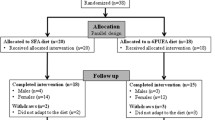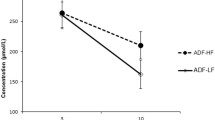Abstract
Objective
To study the effects of the dietary fat content on cardiovascular disease risk factors in humans when the fatty acid composition and types of carbohydrates are kept constant.
Methods
A controlled dietary study in healthy volunteers with 2 dietary groups and a parallel design consisting of 2 dietary periods was conducted. First, participants received a 2-week wash-in diet rich in saturated fatty acids (SFA; 47% of total fatty acids) and were then randomly assigned to either a high-fat (40% of energy) or a low-fat diet (29% of energy) for 4 weeks. Both diets were isocaloric, rich in monounsaturated fatty acids (MUFA; 51% of total fatty acids) and had similar fatty acid and carbohydrate compositions.
Results
Compared to the wash-in diet, the high-fat and low-fat diets significantly lowered LDL-cholesterol (−0.34 and −0.41 mmol/l, respectively; P < 0.001 for time effect in RM-ANOVA), and HDL-cholesterol (−0.13 and −0.18 mmol/l, respectively; P < 0.001 for time), without any differences between the high-fat and low-fat diets (P = 0.112 and P = 0.085 for time × group interaction in RM-ANOVA, respectively). The size of the major LDL fraction, the LDL susceptibility to oxidation and the plasma concentrations of oxidized LDL (ox-LDL) were significantly reduced by both the high-fat and low-fat diet, again without significant differences between the diets. The ratio of ox-LDL/LDL-cholesterol, serum triacylglycerols and urinary F2-isoprostanes were not significantly affected by the diets.
Conclusion
A high-fat and a low-fat diet, both rich in MUFA, had similar effects on lipid-related cardiovascular disease risk factors in metabolically healthy men and women.
Similar content being viewed by others
References
Mackay J, Mensah GA (2004) The atlas of heart disease and stroke. World Health Organization (WHO), Geneva
Glass CK, Witztum JL (2001) Atherosclerosis: the road ahead. Cell 104:503–516
Kratz M, Cullen P, Wahrburg U (2002) The impact of dietary mono- and polyunsaturated fatty acids on risk factors for atherosclerosis in humans. Eur J Lipid Sci Technol 104:300–311
Lapointe A, Couillard C, Lemieux S (2006) Effects of dietary factors on oxidation of low-density lipoprotein particles. J Nutr Biochem 17:645–658
Erkkilä A, de Mello VD, Risérus U, Laaksonen DE (2008) Dietary fatty acids and cardiovascular disease: an epidemiological approach. Prog Lipid Res 47:172–187
Jakobsen MU, O’Reilly EJ, Heitmann BL, Pereira MA, Balter K, Fraser GE, Goldbourt U, Hallmans G, Knekt P, Liu S, Pietinen P, Spiegelman D, Stevens J, Virtamo J, Willett WC, Ascherio A (2009) Major types of dietary fat and risk of coronary heart disease: a pooled analysis of 11 cohort studies. Am J Clin Nutr 89:1425–1432
Siri-Tarino PW, Sun Q, Hu FB, Krauss RM (2010) Saturated fat, carbohydrate, and cardiovascular disease. Am J Clin Nutr 91:502–509
National Cholesterol Education Program (NCEP) (2001) Expert panel on detection, evaluation, and treatment of high blood cholesterol in adults. Executive summary of the third report of the Expert Panel (Adult Treatment Panel III). JAMA 285:2486–2497
Lichtenstein AH, Appel LJ, Brands M, Carnethon M, Daniels S, Franch HA, Franklin B, Kris-Etherton P, Harris WS, Howard B, Karanja N, Lefevre M, Rudel L, Sacks F, Van Horn L, Winston M, Wylie-Rosett J (2006) Diet and lifestyle recommendations revision 2006: a scientific statement from the American Heart Association Nutrition Committee. Circulation 114:82–96
World Health Organization (WHO) (2003) Diet, nutrition and the prevention of chronic diseases: Report of a Joint WHO/FAO Expert Consultation (WHO Technical Report Series Vol. 916). World Health Organization (WHO). WHO Technical Report Series 916. World Health Organization (WHO), Geneva
Willet WC (2002) Dietary fat plays a major role in obesity: no. Obes Rev 3:59–68
Sanders TA (2003) High- versus low-fat diets in human diseases. Curr Opin Clin Nutr Metab Care 6:151–155
Katan MB, Grundy SM, Willett WC (1997) Should a low-fat, high-carbohydrate diet be recommended for everyone? Beyond low-fat diets. N Engl J Med 337:563–566
Astrup A, Astrup A, Buemann B, Flint A, Raben A (2002) Low-fat diets and energy balance: how does the evidence stand in 2002? Proc Nutr Soc 61:299–309
Pieke B, von Eckardstein A, Gülbahçe E, Chirazi A, Schulte H, Assmann G, Wahrburg U (2000) Treatment of hypertriglyceridemia by two diets rich either in unsaturated fatty acids or in carbohydrates: effects on lipoprotein subclasses, lipolytic enzymes, lipid transfer proteins, insulin and leptin. Int J Obes Relat Metab Disord 24:1286–1296
Siri-Tarino PW, Sun Q, Hu FB, Krauss RM (2010) Saturated fat, carbohydrate, and cardiovascular disease. Am J Clin Nutr 91:502–509
Mozaffarian D (2005) Effects of dietary fats versus carbohydrates on coronary heart disease: a review of the evidence. Curr Atheroscler Rep 7:435–445
Kratz M, Gülbahçe E, von Eckardstein A, Cullen P, Cignarella A, Assmann G, Wahrburg U (2002) Dietary mono- and polyunsaturated fatty acids similarly affect LDL size in healthy men and women. J Nutr 132:715–718
Egert S, Somoza V, Kannenberg F, Fobker M, Krome K, Erbersdobler HF, Wahrburg U (2007) Influence of three rapeseed oil-rich diets, fortified with alpha-linolenic acid, eicosapentaenoic acid or docosahexaenoic acid on the composition and oxidizability of low-density lipoproteins: results of a controlled study in healthy volunteers. Eur J Clin Nutr 61:314–325
Esterbauer H, Striegl G, Puhl H, Rotheneder M (1989) Continuous monitoring of in vitro oxidation of human low density lipoprotein. Free Radic Res Commun 6:67–75
Jacobs B, Angelis-Schierbaum G, Egert S, Assmann G, Kratz M (2004) Individual serum triglyceride responses to high-fat and low-fat diets differ in men with modest and severe hypertriglyceridemia. J Nutr 134:1400–1405
Mensink RP, de Groot MJ, van den Broeke LT, Severijnen-Nobels AP, Demacker PN, Katan MB (1989) Effects of monounsaturated fatty acids v complex carbohydrates on serum lipoproteins and apoproteins in healthy men and women. Metabolism 38:172–178
Mensink RP, Katan MB (1987) Effect of monounsaturated fatty acids versus complex carbohydrates on high-density lipoproteins in healthy men and women. Lancet 1:122–125
Dreon DM, Fernstrom HA, Miller B, Krauss RM (1995) Apolipoprotein E isoform phenotype and LDL subclass response to a reduced-fat diet. Arterioscler Thromb Vasc Biol 15:105–111
Krauss RM, Dreon DM (1995) Low-density-lipoprotein subclasses and response to a low-fat diet in healthy men. Am J Clin Nutr 62:478S–487S
Campos H, Dreon DM, Krauss RM (1995) Associations of hepatic and lipoprotein lipase activities with changes in dietary composition and low density lipoprotein subclasses. J Lipid Res 36:462–472
Grundy SM, Florentin L, Nix D, Whelan MF (1988) Comparison of monounsaturated fatty acids and carbohydrates for reducing raised levels of plasma cholesterol in man. Am J Clin Nutr 47:965–969
Sirtori CR, Tremoli E, Gatti E, Montanari G, Sirtori M, Colli S, Gianfranceschi G, Maderna P, Dentone CZ, Testolin G (1986) Controlled evaluation of fat intake in the Mediterranean diet: comparative activities of olive oil and corn oil on plasma lipids and platelets in high-risk patients. Am J Clin Nutr 44:635–642
Kris-Etherton PM, Pearson TA, Wan Y, Hargrove RL, Moriarty K, Fishell V, Etherton TD (1999) High-monounsaturated fatty acid diets lower both plasma cholesterol and triacylglycerol concentrations. Am J Clin Nutr 70:1009–1015
Wahrburg U, Martin H, Sandkamp M, Schulte H, Assmann G (1992) Comparative effects of a recommended lipid-lowering diet vs a diet rich in monounsaturated fatty acids on serum lipid profiles in healthy young adults. Am J Clin Nutr 56:678–683
Kratz M, Cullen P, Kannenberg F, Kassner A, Fobker M, Abuja PM, Assmann G, Wahrburg U (2002) Effects of dietary fatty acids on the composition and oxidizability of low-density lipoprotein. Eur J Clin Nutr 56:72–81
Ginsberg HN, Kris-Etherton P, Dennis B, Elmer PJ, Ershow A, Lefevre M, Pearson T, Roheim P, Ramakrishnan R, Reed R, Stewart K, Stewart P, Phillips K, Anderson N (1998) Effects of reducing dietary saturated fatty acids on plasma lipids and lipoproteins in healthy subjects: the DELTA Study, protocol 1. Arterioscler Thromb Vasc Biol 18:441–449
Mensink RP, Zock PL, Kester AD, Katan MB (2003) Effects of dietary fatty acids and carbohydrates on the ratio of serum total to HDL cholesterol and on serum lipids and apolipoproteins: a meta-analysis of 60 controlled trials. Am J Clin Nutr 77:1146–1155
Mensink RP, Katan MB (1992) Effect of dietary fatty acids on serum lipids and lipoproteins. A meta-analysis of 27 trials. Arterioscler Thromb 12:911–919
Gardner CD, Kraemer HC (1995) Monounsaturated versus polyunsaturated dietary fat and serum lipids. A meta-analysis. Arterioscler Thromb Vasc Biol 15:1917–1927
Kris-Etherton PM, Kris-Etherton PM, Binkoski AE, Zhao G, Coval SM, Clemmer KF, Hecker KD, Jacques H, Etherton TD (2002) Dietary fat: assessing the evidence in support of a moderate-fat diet; the benchmark based on lipoprotein metabolism. Proc Nutr Soc 61:287–298
Hargrove RL, Etherton TD, Pearson TA, Harrison EH, Kris-Etherton PM (2001) Low fat and high monounsaturated fat diets decrease human low density lipoprotein oxidative susceptibility in vitro. J Nutr 131:1758–1763
O’Bryne DJ, O’Keefe SF, Shireman RB (1998) Low-fat, monounsaturate-rich diets reduce susceptibility of low density lipoproteins to peroxidation ex vivo. Lipids 33:149–157
Ylä-Herttuala S, Palinski W, Rosenfeld ME, Parthasarathy S, Carew TE, Butler S, Witztum JL, Steinberg D (1989) Evidence for the presence of oxidatively modified low density lipoprotein in atherosclerotic lesions of rabbit and man. J Clin Invest 84:1086–1095
Morrow JD (2005) Quantification of isoprostanes as indices of oxidant stress and the risk of atherosclerosis in humans. Arterioscler Thromb Vasc Biol 25:279–286
Lamarche B, Lemieux I, Despres JP (1999) The small, dense LDL phenotype and the risk of coronary heart disease: epidemiology, patho-physiology and therapeutic aspects. Diabetes Metab 25:199–211
Groener JE, van Ramshorst EM, Katan MB, Mensink RP, van Tol A (1991) Diet-induced alteration in the activity of plasma lipid transfer protein in normolipidemic human subjects. Atherosclerosis 87:221–226
Jansen S, Lopez-Miranda J, Castro P, Lopez-Segura F, Marin C, Ordovas JM, Paz E, Jimenez-Pereperez J, Fuentes F, Perez-Jimenez F (2000) Low-fat and high-monounsaturated fatty acid diets decrease plasma cholesterol ester transfer protein concentrations in young, healthy, normolipemic men. Am J Clin Nutr 72:36–41
Chung BH, Segrest JP, Franklin F (1998) In vitro production of beta-very low density lipoproteins and small, dense low density lipoproteins in mildly hypertriglyceridemic plasma: role of activities of lecithin:cholester acyltransferase, cholesterylester transfer proteins and lipoprotein lipase. Atherosclerosis 141:209–225
Acknowledgments
This study was financially supported by the German Union for the Promotion of Oil- and Protein-containing Plants (UFOP).
Conflict of interest statement
None.
Author information
Authors and Affiliations
Corresponding author
Rights and permissions
About this article
Cite this article
Egert, S., Kratz, M., Kannenberg, F. et al. Effects of high-fat and low-fat diets rich in monounsaturated fatty acids on serum lipids, LDL size and indices of lipid peroxidation in healthy non-obese men and women when consumed under controlled conditions. Eur J Nutr 50, 71–79 (2011). https://doi.org/10.1007/s00394-010-0116-9
Received:
Accepted:
Published:
Issue Date:
DOI: https://doi.org/10.1007/s00394-010-0116-9




